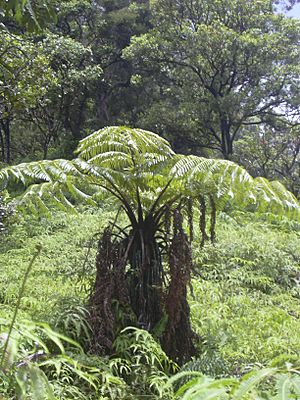Hawaiian tree fern facts for kids
Quick facts for kids Hāpuʻu ʻiʻi |
|
|---|---|
 |
|
| Scientific classification | |
| Genus: |
Cibotium
|
| Species: |
menziesii
|
Cibotium menziesii, also known as the Hawaiian tree fern, is a special type of tree fern that grows only on the Hawaiian Islands. It was named after a Scottish nature expert, Archibald Menzies. People sometimes call it the 'male tree fern' because of its color, while another fern, Cibotium glaucum, is called the 'female tree fern'.
Contents
About the Hawaiian Tree Fern
The Hāpuʻu ʻiʻi can grow very tall, sometimes up to 35 feet (11 m)! But usually, they are about 7 to 25 feet (2.1 to 7.6 m) high. Their trunks can be nearly 3 feet (0.91 m) wide, making them Hawaiʻi's biggest tree ferns.
The trunk is made of strong, hard fibers. Inside, there's a soft, starchy center called the pith. The fern's fronds (which are like big leaves) are green with yellow lines in the middle. They are lighter in color on the underside. These fronds can grow as long as 12 feet (3.7 m). The stems of the fern are covered in red or black bristles. Each frond divides once, and then divides again at the ends where the spores are formed.
How it Reproduces
This fern makes new plants using tiny spores. These spores are released from the ends of the fronds. For growing ferns at home or for selling, people collect spores from the lower fronds. They treat these spores with heat and water, then keep them cool. You can also grow new ferns from side shoots that grow off the main trunk. These shoots need to be cut very close to the trunk.
Where it Lives
Cibotium menziesii is found only in the wet, windward (windy and rainy) parts of the main Hawaiian islands. It grows in rainforests at heights between 305 to 1,830 metres (1,001 to 6,004 ft) above sea level. These ferns can grow on the ground or even on other trees as an epiphyte (a plant that grows on another plant but doesn't harm it).
Even though it comes from Hawaii, this fern is quite tough. It can handle long, cool winters. Even if it loses its fronds, a little warmth can make new growth appear. Sadly, the number of these ferns is going down. This is because of animals like feral pigs and because too many are being harvested by people.
How People Use It
Food
The starchy center of the fern's trunk can be cooked and eaten. It was an important food source for people during times when food was scarce. This part of the trunk is also a major food source for feral pigs.
Medicine
Native Hawaiians used parts of the hāpuʻu ʻiʻi to make traditional medicines. For example, the pith (the soft center) was mixed with other plants like ʻolena (turmeric) and ʻokolehao liquor to make a 'blood purifier'.
Another medicine was made from the pith of hāpuʻu ʻiʻi and ʻamaʻumaʻu (another fern). This was used to help with chest pain. The heated fibers from the fronds were also used to treat body aches, like muscle pain and stiff joints.
Other Uses
The pulu, which are the soft fibers from the fronds, were used in traditional burials to soak up body fluids. These same fibers are also used today to make soft pillows that are sold as souvenirs.
Long ago, Native Hawaiians would hollow out the fern's trunk and use it as a planter for uhi (a type of yam). This practice is still done today.

